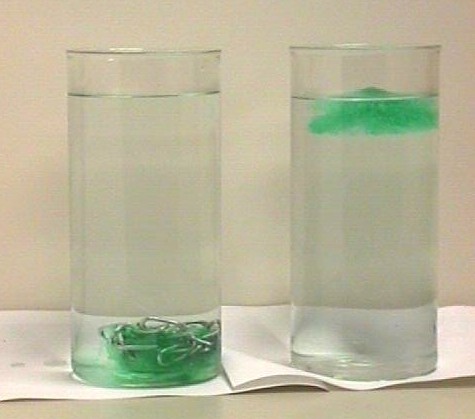Comparing Heat Transfer by Convection and Conduction
Dale Durran and Yaga Beres
Purpose:
To
compare two methods of heat transfer in the atmosphere: convection and
conduction
Equipment:
Two
tall cylindrical beakers, water, food coloring, 2 salsa containers, a
short
piece of metal chain.
Early
Preparation:
The
metal chain is placed in one salsa container. Subsequently both salsa
containers
are filled with equal amounts of water dyed by food coloring and placed
in the freezer until the water is frozen.
Procedure:
1) Two tall beakers, A and B, are filled with hot water (3/4 full only).
2)
Ice chunks are taken out of the salsa containers and carefully placed
in
the tall beakers: The ice with chain in Beaker A; the ice without chain
in Beaker B.
What
happens?
| |
Beaker
A
|
Beaker
B
|
Immediately:
- The
ice without chain floats near the surface of Beaker B
- The
ice with chain sinks to the bottom of Beaker A
|

|
After
few minutes:
- In Beaker A, the cold, colored water remains near the bottom of the beaker, and hot clear water stays near the top
- In Beaker B, the dyed water melted from the ice quickly starts sinking down and warmer water from the bottom of the beaker rises to replace it
|
 |
After
30 minutes:
- The
ice
is still largely
unmelted at the bottom of the beaker A. Just above the surface of the
ice,
there is a small layer of colored water. Above that level, the water is
clear and much warmer than the ice (at a temperature fairly close to
it's
initial temperature)
- In
Beaker
B, all ice
has melted, and all of the water in the beaker is of uniform
temperature
and color
|
 |
Explanation:
Warm water is more buoyant than cold water. Since warm water is below the ice and cold water in Beaker B, the warm water rises, whereas the cold water sinks. This is convection in action!
In Beaker A, on
the other hand, the warm buoyant water overlays the cold ice. This is a
very stable arrangement, and convection does not occur. Heat
transfer
only occurs through conduction in this case.
Conclusion:
In fluids, such as
water and air, convection is a much more efficient method of heat
transfer
than conduction. This difference in efficiency produced the
dramatic
difference in the time required to melt the ice. Although conduction
was
at work in both cases, it transferred much less heat than convection.
Related Links:
YouTube Video
Back to Dale Durran's
home page


